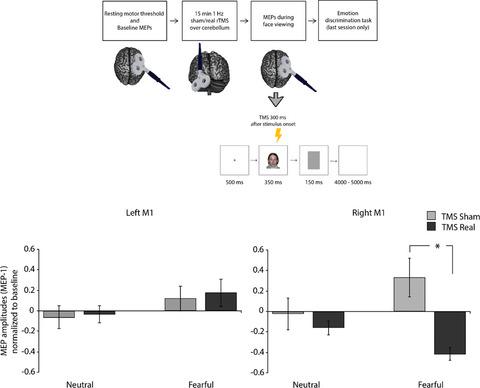当前位置:
X-MOL 学术
›
Eur. J. Neurosci.
›
论文详情
Our official English website, www.x-mol.net, welcomes your feedback! (Note: you will need to create a separate account there.)
TMS over the posterior cerebellum modulates motor cortical excitability in response to facial emotional expressions
European Journal of Neuroscience ( IF 3.698 ) Pub Date : 2020-08-28 , DOI: 10.1111/ejn.14953 Chiara Ferrari 1 , Francesca Fiori 2 , Boris Suchan 3 , Ela B. Plow 4 , Zaira Cattaneo 2, 5
European Journal of Neuroscience ( IF 3.698 ) Pub Date : 2020-08-28 , DOI: 10.1111/ejn.14953 Chiara Ferrari 1 , Francesca Fiori 2 , Boris Suchan 3 , Ela B. Plow 4 , Zaira Cattaneo 2, 5
Affiliation

|
Evidence suggests that the posterior cerebellum is involved in emotional processing. Specific mechanisms by which the cerebellum contributes to the perception of and reaction to the emotional state of others are not well‐known. It is likely that perceived emotions trigger anticipatory/preparatory motor changes. However, the extent to which the cerebellum modulates the activity of the motor cortex to contribute to emotional processing has not been directly investigated. In this study, we assessed whether the activity of the posterior cerebellum influences the modulation of motor cortical excitability in response to emotional stimuli. To this end, we transiently disrupted the neural activity of the left posterior cerebellum using 1 Hz repetitive transcranial magnetic stimulation (rTMS) and examined its effect on motor cortical excitability witnessed during emotional face processing (in comparison to the effects of sham rTMS). Motor excitability was measured as TMS‐based motor evoked potentials (MEPs) recorded from bilateral first dorsal interosseous (FDI) muscles during the viewing of negative emotional (i.e. fearful) and neutral facial expressions. In line with previous evidence, we found that MEP amplitude was increased during the viewing of fearful compared to neutral faces. Critically, when left posterior cerebellar activity was transiently inhibited with 1 Hz rTMS, we observed a reduction in amplitude of MEPs recorded from the contralateral (right) motor cortex during the viewing of emotional (but not neutral) faces. In turn, inhibition of the left posterior cerebellum did not affect the amplitude of MEPs recorded from the ipsilateral motor cortex. Our findings suggest that the posterolateral (left) cerebellum modulates motor cortical response to negative emotional stimuli and may serve as an interface between limbic, cognitive, and motor systems.
中文翻译:

小脑后部的TMS响应面部情绪表达来调节运动皮层兴奋性
有证据表明,小脑后部参与了情绪加工。小脑促进他人情绪状态的感知和反应的特定机制尚不清楚。感知到的情绪可能触发预期/预备的运动变化。但是,小脑调节运动皮层活动以促进情绪加工的程度尚未得到直接研究。在这项研究中,我们评估了后小脑的活动是否会影响情绪刺激对运动皮层兴奋性的调节。为此,我们使用1 Hz重复经颅磁刺激(rTMS)暂时破坏了左后小脑的神经活动,并检查了它在情绪面部处理过程中对运动皮层兴奋性的影响(与假rTMS的影响相比)。运动兴奋性是通过在观察负面情绪(即恐惧)和中性面部表情时从双侧第一背骨间(FDI)肌肉记录的基于TMS的运动诱发电位(MEP)来衡量的。与以前的证据一致,我们发现与中性面孔相比,在观看恐惧时MEP幅度增加了。至关重要的是,当使用1 Hz rTMS暂时抑制左后小脑活动时,我们观察到在观看情感性(而非中性)面孔时,从对侧(右)运动皮层记录到的MEP幅度降低。反过来,抑制左小脑并不会影响从同侧运动皮层记录的MEP幅度。我们的研究结果表明,小脑后外侧(左)调节运动皮层对负面情绪刺激的反应,并且可能充当边缘,认知和运动系统之间的接口。
更新日期:2020-08-28
中文翻译:

小脑后部的TMS响应面部情绪表达来调节运动皮层兴奋性
有证据表明,小脑后部参与了情绪加工。小脑促进他人情绪状态的感知和反应的特定机制尚不清楚。感知到的情绪可能触发预期/预备的运动变化。但是,小脑调节运动皮层活动以促进情绪加工的程度尚未得到直接研究。在这项研究中,我们评估了后小脑的活动是否会影响情绪刺激对运动皮层兴奋性的调节。为此,我们使用1 Hz重复经颅磁刺激(rTMS)暂时破坏了左后小脑的神经活动,并检查了它在情绪面部处理过程中对运动皮层兴奋性的影响(与假rTMS的影响相比)。运动兴奋性是通过在观察负面情绪(即恐惧)和中性面部表情时从双侧第一背骨间(FDI)肌肉记录的基于TMS的运动诱发电位(MEP)来衡量的。与以前的证据一致,我们发现与中性面孔相比,在观看恐惧时MEP幅度增加了。至关重要的是,当使用1 Hz rTMS暂时抑制左后小脑活动时,我们观察到在观看情感性(而非中性)面孔时,从对侧(右)运动皮层记录到的MEP幅度降低。反过来,抑制左小脑并不会影响从同侧运动皮层记录的MEP幅度。我们的研究结果表明,小脑后外侧(左)调节运动皮层对负面情绪刺激的反应,并且可能充当边缘,认知和运动系统之间的接口。



























 京公网安备 11010802027423号
京公网安备 11010802027423号